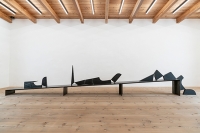Tapta — Flexible Forms
My older sister told me that once, as a little girl, I arranged all my toys in a beautiful circle and started to dance between them and sing: “I’m Tapta, Tapta, Tapta.” The family liked it, and I became Tapta. Forever.
Tapta, 1997
Tapta (the pseudonym of Maria Wierusz-Kowalska, born Maria Irena Boyé) was born in Poland in 1926 and came to Belgium as a political refugee with her husband, Krzysztof, after taking part in the Warsaw Uprising of 1944. She studied weaving at the La Cambre, the National School of Visual Arts in Brussels, from where she graduated in 1949. Shortly afterwards, the couple moved to the Belgian Congo (now Democratic Republic of the Congo), where they lived from 1950 to 1960. On their return to Belgium in 1960, until her sudden death in 1997, Tapta worked in Brussels as an artist and – from 1976 until 1990 – as a professor at La Cambre.
Oddly enough, the above quote about how Tapta got her nickname, and later artist’s name, already hints at some of the basic principles within her artistic practice: just as she, as a child, formed a ‘beautiful circle’ with her toys and then began to dance and sing between them, later as an artist she would search for aesthetical shapes that – beyond mere visual perception – also invite you to move around, between or even inside them. In addition, however heavy and imposing some of her works may appear, the playful element would always be present.
Tapta: Flexible Forms is the first large-scale retrospective dedicated to Tapta outside of Belgium, her adopted home country where she gained citizenship. The title of the exhibition refers to the central concept of her oeuvre: the creation of sculptures which interact with the exhibition space and the viewer through their flexible forms.
Installed in a loosely chronological order, the exhibition gives an overview of Tapta’s oeuvre, which is mainly divided into two periods: the textile works made in the 1960s until the early 1980s and the works in neoprene from the 1980s and 1990s.
In 1969, Tapta participated in the 4th International Biennial of Tapestry in Lausanne, where her work was displayed alongside those of Magdalena Abakanowicz, Jagoda Buić, Elsi Giauque and Sheila Hicks. This encounter encouraged her to continue along the path of unconventional experimentation with textiles, which she had started in the early 1960s. Steadily distancing herself from traditional weaving by twisting her woven pieces and using ropes, her work protruded outwards from the wall, became more three-dimensional and increasingly interacted with its surroundings and visitors.
Tapta’s activation of the viewer, as seen in the textile sculptures, also manifests itself in the black neoprene works that she began making in the late 1980s and which – following an intermediate phase of experimenting with rubber and stretching ropes across the vaults of the exhibition spaces – marked a radical turn in her use of materials. Handcrafted rope sculptures now gave way to sculptures and installations from the industrially manufactured material, neoprene – further developing her idea of ‘flexible sculpture’.
Next to a selection of twenty-six works, the exhibition displays more than forty scale models, by means of which Tapta invented both her textile and her neoprene sculptures. As such, Tapta: Flexible Forms highlights the remarkable body of work by an artist who remains largely undiscovered outside of Belgium.
Articles
| Title | Type | Issue | Images | Détails |
|---|---|---|---|---|
| Tapta | Hinweis | Kunstbulletin 9/2024 |

|
Institutions
| Title | Country | City | Détails |
|---|---|---|---|
| Muzeum Susch | Suisse
|
Susch
|
Suisse
Susch
|








